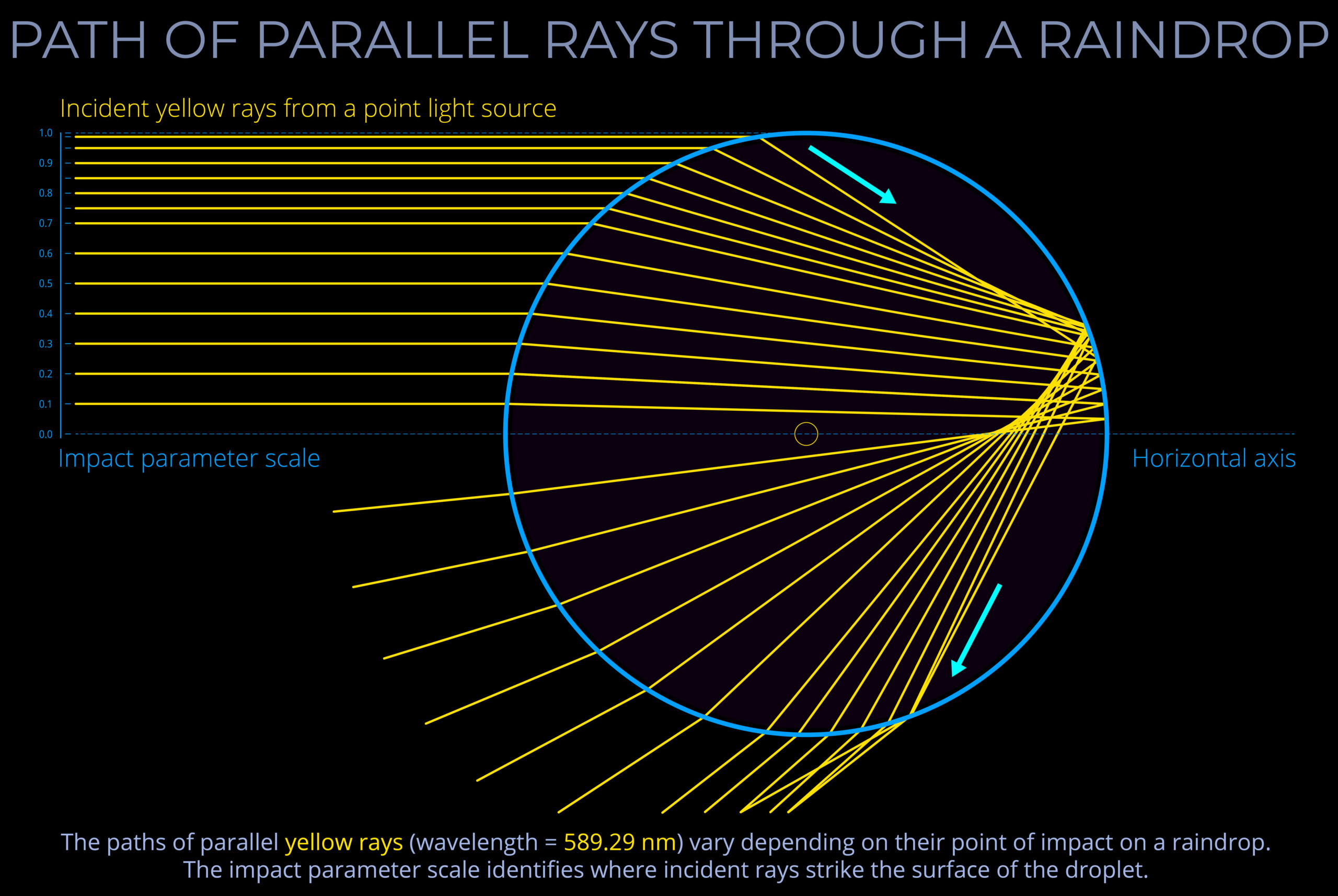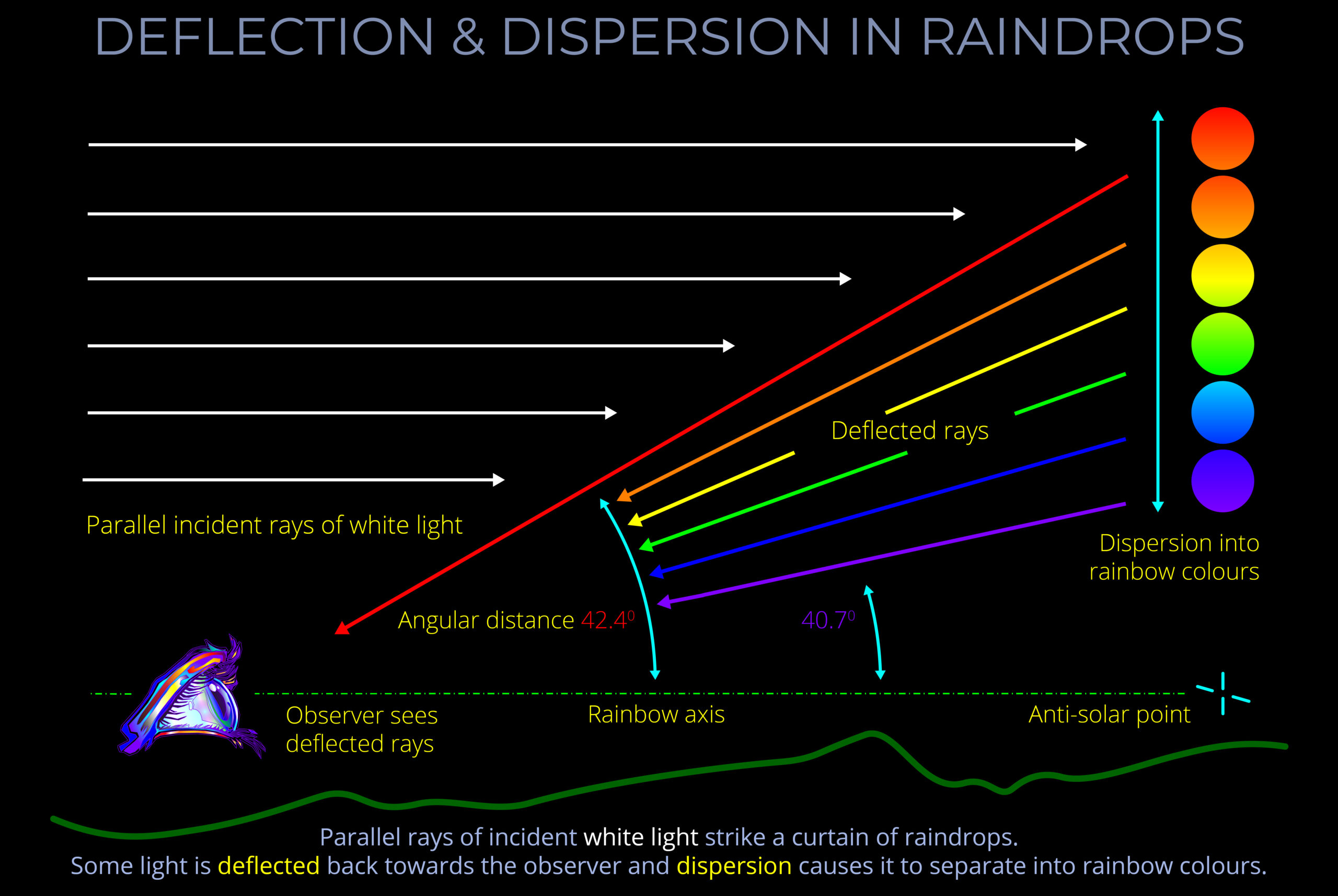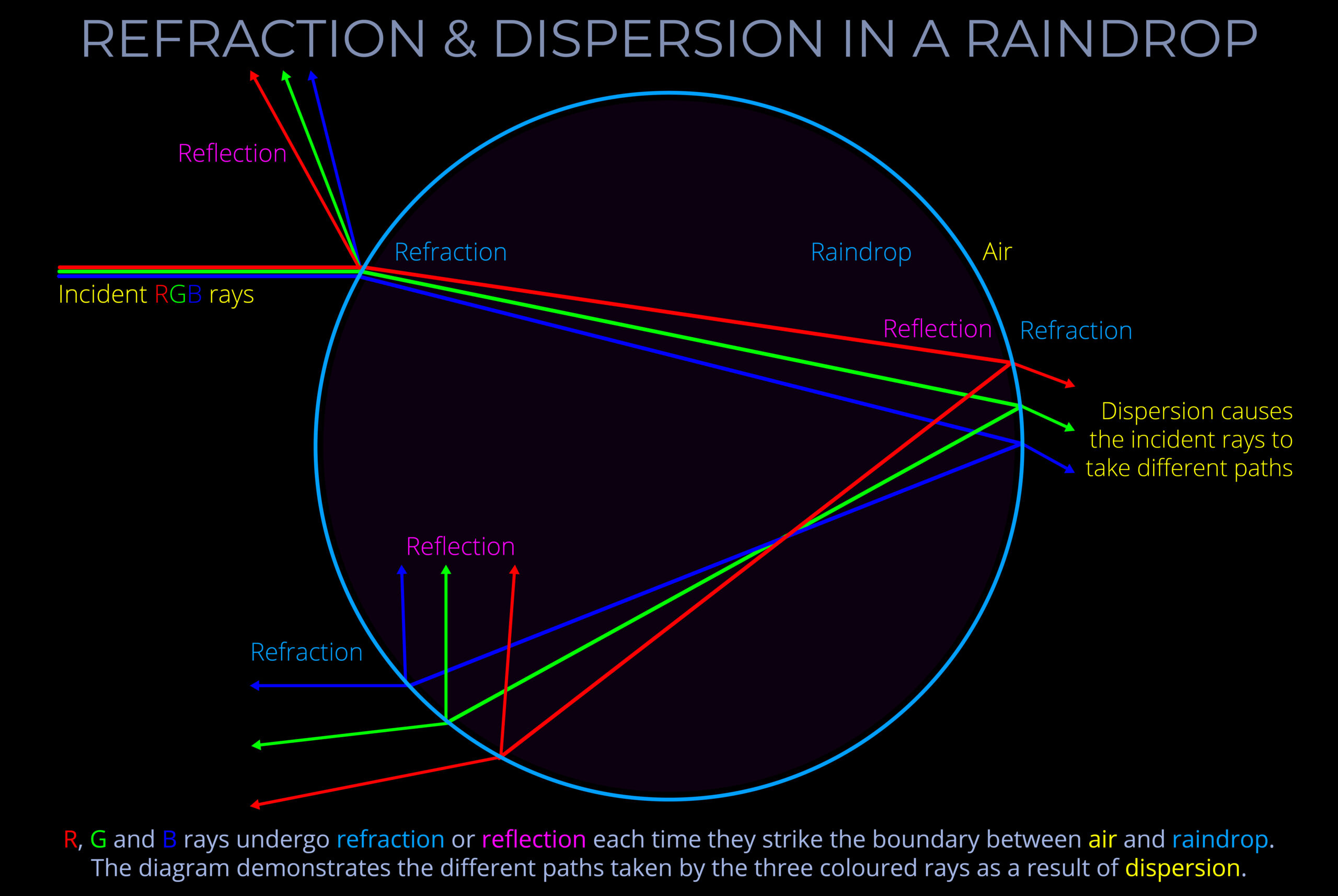Scattering occurs when light waves interact with particles or irregularities within a medium, causing the light to change direction. This can happen when light encounters obstacles such as molecules in the atmosphere, dust particles, or surface imperfections.
- Scattering happens when individual photons or light waves are deflected in different directions, depending on the medium’s composition, particle size, and surface properties.
- Scattering contributes to various natural phenomena, such as the sky’s blue colour, the whiteness of clouds, and the shimmering of water surfaces.
- Scattering differs from other optical phenomena:
- Reflection: Light bounces back, as in a mirror.
- Refraction: Light is bent as it passes through different materials.
- Diffraction: Light spreads out after encountering an obstacle.
- Absorption: Light is absorbed by the material and not re-emitted.Scattering differs from other optical phenomena.
- Scattering can be effectively subdivided into regular and random scattering, each characterized by distinct mechanisms and patterns of light interaction.
Regular Scattering
- Regular scattering occurs when light interacts with a surface or medium that is ordered, structured, or smooth. The result is a predictable and organized pattern, often producing distinct interference patterns or clear directional scattering. Examples include:
- Soap bubbles: When sunlight hits a soap bubble, the light is scattered in a regular, organized way by the thin film of the bubble. This regular scattering produces the shimmering, rainbow-like colours you often see. The scattering observed in soap bubbles is primarily due to interference.
- Water ripples: When sunlight reflects off the rippled surface of a pond or swimming pool, the light scatters in predictable patterns due to the regular shape of the waves, creating sparkling or shimmering effects on the water. This type of scattering is often described as specular scattering or reflection.
Random Scattering
- Random scattering occurs when light interacts with surfaces or particles that are uneven, irregular, or randomly distributed. This type of scattering causes light to be redirected in multiple, unpredictable directions. As a result, no clear or organized pattern of scattered light is produced. Examples include:
- Fog or mist: When driving through fog, the headlights scatter in all directions because of the tiny water droplets in the air. This makes it hard to see far ahead, as the light doesn’t reflect back clearly. The scattering produced by fog or mist is known as Mie scattering.
- Frosted glass: The rough surface of frosted glass scatters light randomly, which prevents you from seeing clear images through it, creating a blurred effect while still allowing light to pass. The scattering produced by frosted glass is known as diffuse scattering.
- White paper: When light hits the surface of white paper, it scatters randomly in different directions. This causes the paper to appear uniformly bright from all angles because the light is diffusely reflected. The scattering produced by white paper is known as non-selective scattering.
- Clouds: Clouds contain water droplets that are much larger than the wavelength of light. This causes all wavelengths of light (and thus all colours) to scatter equally, which is why clouds appear white or grey, depending on their thickness. The scattering produced by clouds is known as non-selective scattering.
- Blue sky: The blue sky is a result of sunlight interacting with gas molecules in the atmosphere, which are much smaller than the wavelength of visible light. Shorter wavelengths of light (blue and violet) scatter more than longer wavelengths (red and yellow), giving the sky its blue colour during the day. The scattering responsible for the blue sky is known as Rayleigh scattering.
About regular scattering
- Regular scattering happens when light bounces off a smooth, curved surface in a predictable way, creating a clear and undistorted image.
- Think about a spoon in a glass of water. The smooth, curved surface of the spoon predictably bends the light, making the spoon appear slightly bent or magnified. This is an example of regular scattering.
- Regular scattering often occurs when parallel rays of light hit smooth, transparent objects like raindrops or prisms. In these cases, the light bends (refracts) in a predictable way depending on the angle it hits the object and the materials involved.
- This predictable bending can sometimes separate white light into its component colours, creating a rainbow effect known as chromatic dispersion.
- On a microscopic level, all types of scattering follow the laws of reflection and refraction (Snell’s law).
- Let’s look at two cases of regular scattering in more detail:
- When parallel rays of light with a single wavelength strike and enter an object like a raindrop or prism, their path depends on the initial point of impact, the refractive indices of air and water, and the object’s surface properties.
- When parallel rays of incident light with a single wavelength meet the curved surface of a transparent medium at various points, the different angles at which they strike the surface and experience deflection mainly determine how they scatter as they exit the medium.
About random scattering
Random scattering
- Random scattering occurs when a material, due to irregularities or imperfections on its surface, reflects or transmits light rays in various unpredictable directions.
- This scattering can produce a variety of effects:
- Reflected light may appear hazy or lack detail, or there may be no clear reflection at all.
- When light passes through sheets of glass with irregular yet smooth surfaces, random scattering distorts the view of the world beyond, making the image blurry and confused.
- A reflection that is free of the effects of random scattering is called a specular reflection. Mirrors generally produce specular reflections.
Diffuse light
- Diffuse light is a specific type of random scattering that occurs when light bounces off rough or uneven surfaces.
- In these cases, the light scatters in all directions, creating a soft, even glow.
- The overall structure and composition of a material can also cause diffuse light.
- This happens when light travels through a medium that contains foreign materials, suspended particles, or has an irregular internal structure or variations in density.
- Translucent materials containing dissolved substances, however, typically don’t cause random scattering because the particles are too small.
- On a microscopic scale, all objects adhere to the law of reflection; however, when surface irregularities are larger than the wavelength of light, the light undergoes scattering leading to diffusion.
About scattering in raindrops
- Regular scattering, caused by refraction and chromatic dispersion, is responsible for the colours seen in rainbows.
- Refraction occurs when light changes speed and direction as it passes from one transparent medium (like air) to another (like water).
- Chromatic dispersion is the phenomenon where light separates into its various colours, each with a slightly different wavelength, which bend at slightly different angles during refraction.
- Scattering in raindrops obeys the laws of both reflection and refraction, commonly referred to as Snell’s law. Here are three related descriptions of what causes scattering when visible light strikes a raindrop:
- When light of a specific wavelength strikes the surface and enters a raindrop its subsequent path depends upon the point of impact, and the refractive indices of water and air.
- When rays of light of a single wavelength strike a raindrop at different points, scattering is primarily determined by the angles at which they enter the droplet.
- The interaction between refraction and chromatic dispersion gives rise to the appearance of rainbow colours when parallel white light rays strike various points on the surface of a raindrop.


